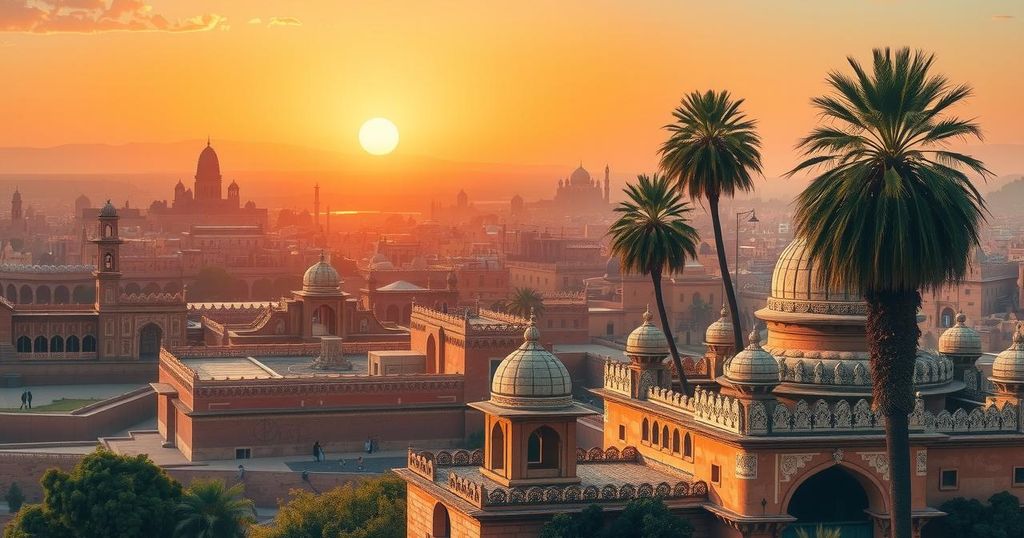Global news
Politics
AP, AP PHOTO, APTN, ASIA, ASSOCIATED PRESS, BASHA, BASHAR ASSAD, BEIRUT, CURRENT EVENTS, EUROPE, FRANCE, HAFEZ ASSAD, HAMA, LEBANON, MICHEL EULER, MUSLIM BROTHERHOOD, NEWS, PARIS, PROTEST, PROTESTS, REFUGEE CRISIS, RI, SHAAM, SHAAM NEWS NETWORK, SYRIA, UGARIT, UGARIT NEWS, UGARIT NEWS GROUP, WAR
Leila Ramsay
0 Comments
The Significance of Hama’s Capture in Syria’s Ongoing Conflict
The Syrian army’s recent withdrawal from Hama signals a critical defeat for President Assad’s regime. Hama’s history is scarred by the Hama Massacre of 1982, characterized by immense loss of life and government brutality. The city’s capture by insurgents symbolizes a resurgence of opposition, potentially reshaping the ongoing civil war. Hama’s strategic location also raises the stakes for future military engagements, particularly regarding Homs.
The Syrian army’s recent withdrawal from Hama signifies a significant setback for President Bashar Assad, as insurgents successfully breached military defenses, enabling them to enter the city. This development has generated considerable attention due to Hama’s tumultuous history, particularly concerning the tragic Hama Massacre conducted by Hafez Assad in February 1982, which resulted in the death of an estimated 10,000 to 40,000 individuals and left a lasting scar on the region.
In the early 1980s, Hama was the focal point of anti-government activities led by the Muslim Brotherhood. The government responded with extreme aggression, inflicting severe damage on the city and resulting in widespread casualties. The brutal campaign was spearheaded by Hafez Assad’s brother, Rifaat, who earned the notorious title “Butcher of Hama.” This gruesome legacy of violence has perpetuated animosity, linking past atrocities to contemporary conflicts between the regime and insurgent groups.
Hama became a symbol of resistance during the 2011 Arab Spring protests when it was an epicenter for opposition against Bashar Assad. Residents temporarily seized control in June 2012, symbolizing liberation from oppressive government forces. Protests featured chants such as “Erhal ya Bashar,” encapsulating the demand for Assad’s departure. However, the city fell back under government control just months later, resulting in significant violence and repression.
Aron Lund of Century International emphasized Hama’s profound symbolic importance within Syrian history, stating it significantly shaped both the opposition and regime perspectives. Lund observed that memories of Hama’s massacre fueled resistance among those opposing Assad during the current civil unrest, as many military leaders had been young at the time, informed by the historical weight of prior events.
Abu Mohammed al-Golani, leader of the insurgent forces, proclaimed the advances into Hama as a move to address the historical injustices of the past 40 years. The initial actions taken by the insurgents included liberating prisoners detained in the city’s central facility.
Geographically, Hama’s strategic location serves as a critical junction connecting various regions of Syria, facilitating movement between the north and south, as well as east and west. The province lies approximately 200 kilometers from Damascus and borders Latakia, a coastal province that supports the Assad regime.
The fall of Hama is poised to bolster insurgent morale and potentially weaken support for Assad’s regime. Analysts speculate that if the insurgency successfully secures Homs next, significant shifts may occur in the conflict, impacting crucial connections to Damascus and coastal strongholds. The current developments suggest a pivotal moment in Syria’s enduring struggle.
The capture of Hama represents a significant turning point in the ongoing conflict in Syria, overshadowing the traumatic history associated with the Hama Massacre. As opposition forces gain ground, they may strengthen resolve among supporters and alter the trajectory of the civil war. The strategic significance of Hama in connecting vital regions of Syria further heightens the importance of this development. Should insurgents continue their advances towards Homs, it could catalyze substantial change in the balance of power within Syria.
Original Source: apnews.com




Post Comment